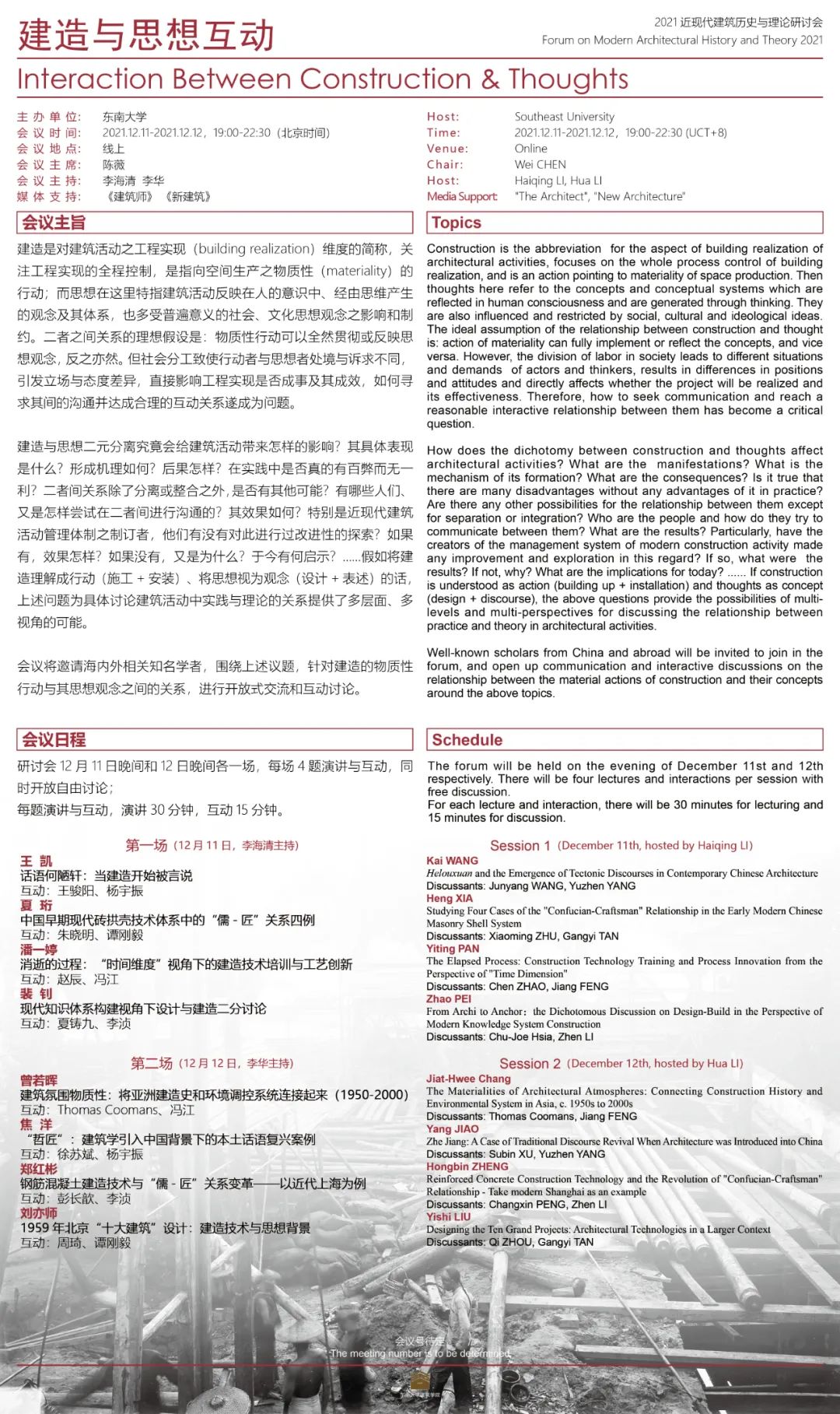2021 近现代建筑历史与理论研讨会
Forum on Modern Architectural History and Theory 2021
建造与思想互动
Interaction Between Construction & Thoughts
主办单位 Host 东南大学 Southeast University
会议时间 Time 北京时间 UCT+8 2021.12.11-2021.12.12,19:00-22:30
会议地点 Venue 线上 Online
会议主席 Chair 陈薇 Wei CHEN
会议主持 Host 李海清 李华 Haiqing LI, Hua LI
媒体支持 Media Support《建筑师》 《新建筑》 "The Architect", "New Architecture"
会议主旨 Topics
建造是对建筑活动之工程实现(building realization)维度的简称,关注工程实现的全程控制,是指向空间生产之物质性(materiality)的行动;而思想在这里特指建筑活动反映在人的意识中、经由思维产生的观念及其体系,也多受普遍意义的社会、文化思想观念之影响和制约。二者之间关系的理想假设是:物质性行动可以全然贯彻或反映思想观念,反之亦然。但社会分工致使行动者与思想者处境与诉求不同,引发立场与态度差异,直接影响工程实现是否成事及其成效,如何寻求其间的沟通并达成合理的互动关系遂成为问题。
Construction is the abbreviation for the aspect of building realization of architectural activities, focuses on the whole process control of building realization, and is an action pointing to materiality of space production. Then thoughts here refer to the concepts and conceptual systems which are reflected in human consciousness and are generated through thinking. They are also influenced and restricted by social, cultural and ideological ideas. The ideal assumption of the relationship between construction and thought is: action of materiality can fully implement or reflect the concepts, and vice versa. However, the division of labor in society leads to different situations and demands of actors and thinkers, results in differences in positions and attitudes and directly affects whether the project will be realized and its effectiveness. Therefore, how to seek communication and reach a reasonable interactive relationship between them has become a critical question.
农耕时代,建造的主体是传统工匠,而思想的主体是传统知识人——儒者(Confucian scholars)。二者社会地位相去甚远,难有交集。除极少数尊贵建筑(noble architecture),大量性建筑活动常掌控于工匠之手,其师徒制倚重口传心授,文字记载匮乏。而儒者则受限于鄙薄生产技艺的传统价值观,对建造也少有关注。北宋将作监李诫已意识到儒匠二分之弊:“斲轮之手,巧或失真;董役之官,才非兼技”,于是在编修《营造法式》过程中“考究经史群书,并勒人匠逐一解说”,以稽参众智,“沟通儒匠、浚发智巧”。
In the agrarian time, the subject of construction was traditional craftsmen, while thoughts’ was the traditional intellectuals, Confucian scholars. Their social status was hardly intersected. Except for very few of noble architectures, most of architectural activities were often controlled by craftsmen whose apprenticeship system relied on oral teaching, hence the written records were scarce. Confucian scholars, who were confined by the traditional values of despising production techniques, paid little attention to construction. Li Jie, the commanding officer worked in the construction department of Northern Song (北宋) was aware of the disadvantages of dichotomy between Confucian scholars and craftsmen: "Although a craftsman is very skillful, sometimes he makes mistakes; while an officer was in charge of construction, he cannot be a master of all types of work". Thus, while compiling and editing the "Ying Zao Fa Shi" (营造法式), he observed and studied a large amount of ancient books on scriptures and history, and asked for the craftsmen’ explaining the actual situation of the project", in order to put heads together, "to make communication between Confucian scholars and craftsmen, to develop both wisdom and skill".
近世以来,现代意识影响下的知识生产、传播及体系建构均发生深刻转变。现代意义、分殊细密、边界清晰的“学科”逐步引入——土木工程学和建筑学;被赋予专司设计职能的是新型知识人——土木工程师以及稍晚登台的建筑师;而传统工匠的建造职能则逐步转由新型体力劳动者——技术工人来承担。建筑活动不复只是真材实料的物质生产和高度复杂的社会生产,也成为新型知识人欲总其事的专业生产。如此,则与古代中国之儒匠二分相似,建造与思想二分依旧存在,成为一些根本问题的诱因。为此,中国营造学社、中国建筑师学会等专业组织以及专业界有识之士做了许多工作。
In modern times, influenced by modern consciousness, the production, dissemination and system of knowledge have been changed profoundly. Disciplines with modern sense and clear boundary are gradually introduced: civil engineering and architecture. The ones taking design as work were new type of intellectuals - civil engineers, and architects who appeared lately. In the meantime, the traditional craftsmen of construction were gradually transferred to a new type of manual laborers - skilled workers. Architecture is no longer a mere material production of real building materials and a highly complex social production, but also professional production in which the new type of intellectuals want to manage. In this way, similar to the dichotomy between Confucian scholars and craftsmen in ancient China, the dichotomy between construction and thoughts still exists and leads to certain fundamental problems. For this reason, professional organizations such as the Society for the Study of Chinese Architecture (中国营造学社), Society of Chinese Architects (中国建筑师学会) and many knowledgeable professionals have done a lot of work.
建造与思想二元分离究竟会给建筑活动带来怎样的影响?其具体表现是什么?形成机理如何?后果怎样?在实践中是否真的有百弊而无一利?二者间关系除了分离或整合之外,是否有其他可能?有哪些人们、又是怎样尝试在二者间进行沟通的?其效果如何?特别是近现代建筑活动管理体制之制订者,他们有没有对此进行过改进性的探索?如果有,效果怎样?如果没有,又是为什么?于今有何启示?……假如将建造理解成行动(施工+安装)、将思想视为观念(设计+表述)的话,上述问题为具体讨论建筑活动中实践与理论的关系提供了多层面、多视角的可能。
How does the dichotomy between construction and thoughts affect architectural activities? What are the manifestations? What is the mechanism of its formation? What are the consequences? Is it true that there are many disadvantages without any advantages of it in practice? Are there any other possibilities for the relationship between them except for separation or integration? Who are the people and how do they try to communicate between them? What are the results? Particularly, have the creators of the management system of modern construction activity made any improvement and exploration in this regard? If so, what were the results? If not, why? What are the implications for today? ...... If construction is understood as action (building up + installation) and thoughts as concept (design + discourse), the above questions provide the possibilities of multi-levels and multi-perspectives for discussing the relationship between practice and theory in architectural activities.
会议将邀请海内外相关知名学者,围绕上述议题,针对建造的物质性行动与其思想观念之间的关系,进行开放式交流和互动讨论。
Well-known scholars from China and abroad will be invited to join in the forum, and open up communication and interactive discussions on the relationship between the material actions of construction and their concepts around the above topics.
会议日程 Schedule
研讨会12月11日晚间和12日晚间各一场,每场4题演讲与互动,同时开放自由讨论;每题演讲与互动,演讲30分钟,互动15分钟。
The forum will be held on the evening of December 11st and 12th respectively. There will be four lectures and interactions per session with free discussion.For each lecture and interaction, there will be 30 minutes for lecturing and 15 minutes for discussion.
第一场(12月11日,李海清主持)
Session 1 (December 11th, hosted by Haiqing LI)
王 凯(Kai WANG) 话语何陋轩:当建造开始被言说Helouxuan and the Emergence of Tectonic Discourses in Contemporary Chinese Architecture互动:王骏阳、杨宇振Discussants: Junyang WANG, Yuzhen YANG
夏 珩(Heng XIA) 中国早期现代砖拱壳技术体系中的“儒-匠”关系四例Studying Four Cases of the "Confucian-Craftsman" Relationship in the Early Modern Chinese Masonry Shell System互动:朱晓明、谭刚毅Discussants: Xiaoming ZHU, Gangyi TAN
潘一婷(Yiting PAN)消逝的过程:“时间维度”视角下的建造技术培训与工艺创新The Elapsed Process: Construction Technology Training and Process Innovation from the Perspective of "Time Dimension"互动:赵辰、冯江Discussants: Chen ZHAO, Jiang FENG
裴 钊(Zhao PEI)现代知识体系构建视角下设计与建造二分讨论From Archi to Anchor:the Dichotomous Discussion on Design-Build in the Perspective of Modern Knowledge System Construction互动:夏铸九、李浈Discussants: Chu-Joe Hsia, Zhen LI
第二场(12月12日,李华主持)
Session 2 (December 12th, hosted by Hua LI)
曾若晖(Jiat-Hwee Chang) 建筑氛围物质性:将亚洲建造史和环境调控系统连接起来(1950-2000)The Materialities of Architectural Atmospheres: Connecting Construction History and Environmental System in Asia, c. 1950s to 2000s互动:Thomas Coomans、冯江Discussants: Thomas Coomans, Jiang FENG
焦 洋(Yang JIAO)“哲匠”:建筑学引入中国背景下的本土话语复兴案例Zhe Jiang: A Case of Traditional Discourse Revival When Architecture was Introduced into China互动:徐苏斌、杨宇振Discussants: Subin XU, Yuzhen YANG
郑红彬(Hongbin ZHENG)钢筋混凝土建造技术与“儒-匠”关系变革——以近代上海为例Reinforced Concrete Construction Technology and the Revolution of "Confucian-Craftsman" Relationship - Take modern Shanghai as an example互动:彭长歆、李浈Discussants: Changxin PENG, Zhen LI
刘亦师(Yishi LIU) 1959年北京“十大建筑”设计:建造技术与思想背景Designing the Ten Grand Projects: Architectural Technologies in a Larger Context互动:周琦、谭刚毅Discussants: Qi ZHOU, Gangyi TAN


